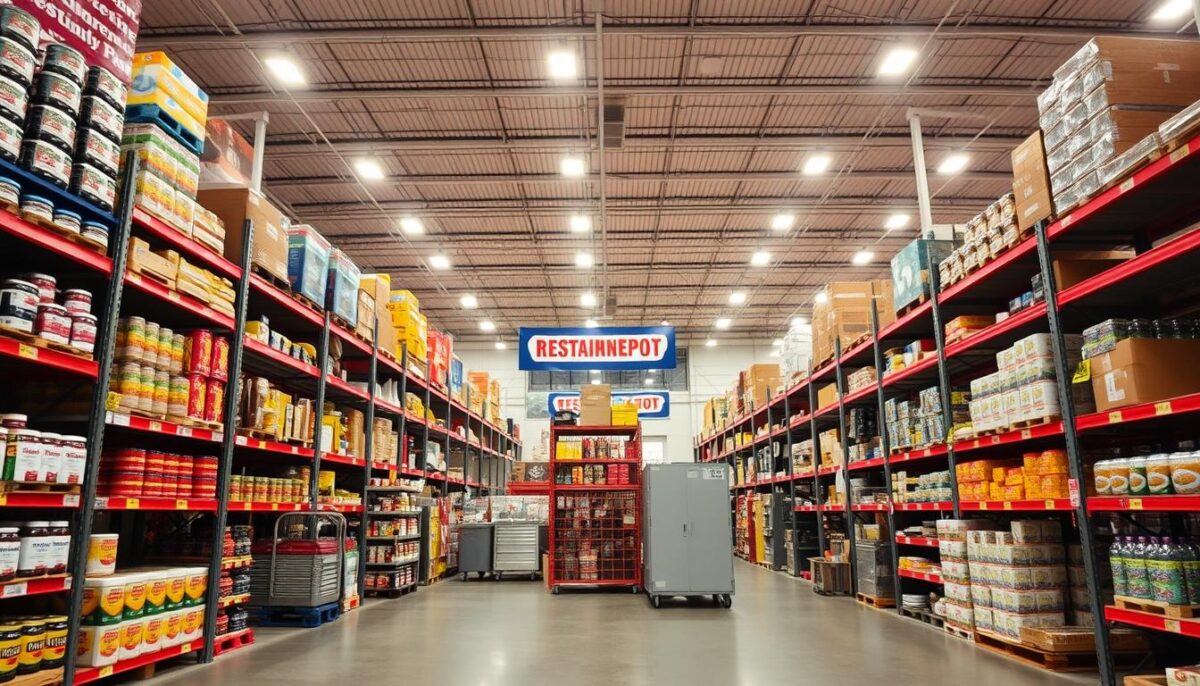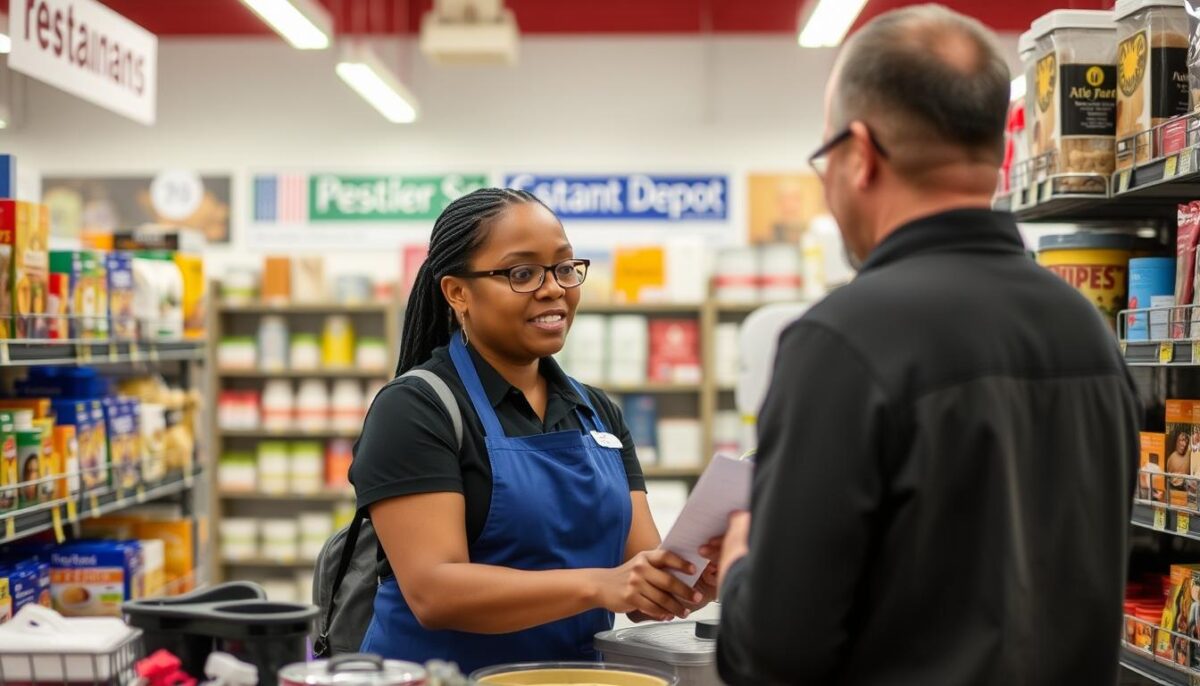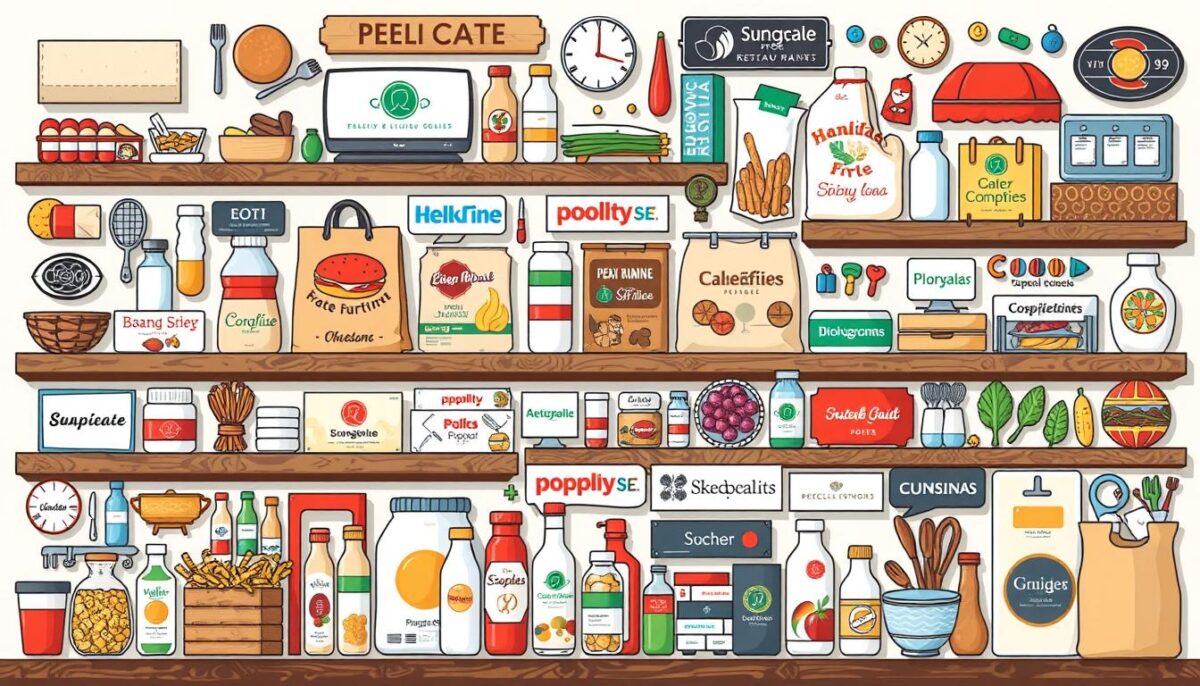
5 Common US Foods Issues—and What You Can Do About Them
October 22, 2025
What Restaurateurs Really Think About Restaurant Depot: Unfiltered Reviews
October 23, 2025As a long-time customer of Restaurant Depot, I’ve experienced my fair share of benefits and frustrations. Like many business owners, I initially turned to this wholesale supplier for its promise of low prices and wide selection. However, I’ve also encountered some surprising challenges that have made me question whether the experience is truly worth it.
A staggering number of customer reviews I researched revealed that I’m not alone in my struggles. In fact, many business owners have reported similar issues, from poor customer service to inconsistent product quality. With over 100 locations across the United States, Restaurant Depot is a significant player in the wholesale food supply industry, serving numerous restaurants, caterers, and food truck operators.
So, what are the most common complaints about Restaurant Depot, and how can you avoid potential pitfalls? Let’s dive into the top 5 issues that business owners face when dealing with this wholesale giant, and explore strategies for navigating these challenges.
Key Takeaways
- Understand the common complaints about Restaurant Depot to better navigate potential issues.
- Learn how to make informed decisions about whether Restaurant Depot is right for your business needs.
- Discover strategies for avoiding potential pitfalls when dealing with this wholesale supplier.
- Get insights into the most frequently reported problems by business owners who have used Restaurant Depot.
- Find out how to save time, money, and frustration when working with Restaurant Depot.
My Experience with Restaurant Depot
Having owned my own business and worked as an Electrical Engineer, I’ve developed a keen eye for quality supplies, which is why I’ve been a loyal customer at Restaurant Depot for over 11 years. I’m currently supplying my customers with products from Restaurant Depot and from vendors out of California.
I first discovered Restaurant Depot over a decade ago when I was looking for wholesale food supplies for my small catering business. It quickly became my go-to source for bulk ingredients due to their extensive inventory and competitive pricing.
Over the years, I’ve developed a love-hate relationship with the company—appreciating their product selection while becoming increasingly frustrated with certain aspects of their operation. I’ve personally experienced several issues, including inventory inconsistencies and quality control problems.
| Aspect | Positive Experience | Negative Experience |
|---|---|---|
| Product Selection | Extensive inventory | Inconsistencies in stock |
| Quality | Generally high-quality products | Occasional quality control issues |
| Customer Service | Helpful staff at times | Challenging interactions |
My goal in sharing these experiences is not to discourage you from shopping at Restaurant Depot but to help you approach it with realistic expectations and strategies to minimize potential headaches.
What is Restaurant Depot and Who Can Shop There?
With over 130 locations across the United States, Restaurant Depot is a go-to destination for business owners seeking quality products at wholesale prices. Restaurant Depot is a members-only wholesale cash and carry foodservice supplier that offers an extensive range of products, from fresh meat and produce to kitchen equipment and cleaning supplies.
Unlike traditional wholesalers, Restaurant Depot doesn’t require minimum purchases or delivery fees—customers simply shop in-store and take their purchases with them. This model is particularly appealing to small business owners who value flexibility and convenience.
Membership Eligibility: To qualify for a free membership account, one must be a business owner in the food service industry, including restaurants, caterers, coffee shops, and non-profit organizations with 501(c)(3) status. As John Smith, a Restaurant Depot customer, noted, “The membership process was straightforward, and the staff were helpful in explaining the benefits.”

Restaurant Depot is owned by Jetro Holdings, LLC, which also operates Jetro Cash & Carry stores, making it one of the largest wholesale food service suppliers in the country. As stated on their website, “We strive to provide our customers with the best products at the best prices.” This commitment to quality and value is what sets Restaurant Depot apart in the industry.
Why Restaurant Depot Complaints Matter for Your Business
Restaurant Depot complaints can significantly impact your business operations, making it essential to be aware of the issues other customers face. As a food business owner, your suppliers directly influence your ability to serve customers consistently and profitably.
Supply chain disruptions, quality issues, or unexpected price changes at Restaurant Depot can create immediate problems for your business. These issues can affect your menu offerings or profit margins, potentially leading to lost sales and revenue.
- Understanding common Restaurant Depot complaints helps you prepare for potential disruptions.
- Time spent dealing with return processes or incorrect charges represents hours away from running your business.
- Customer complaints often highlight systemic issues that could affect your business relationship with Restaurant Depot long-term.
- Being aware of these potential pitfalls allows you to develop contingency plans and alternative supplier relationships.
By staying informed about Restaurant Depot complaints, you can minimize disruptions to your business and ensure continuity of service to your customers. This proactive approach can save you time and money in the long run.
How I Researched These Restaurant Depot Complaints
To assess Restaurant Depot complaints fairly, I looked into customer reviews on multiple websites and forums. My research involved analyzing hundreds of customer reviews across platforms like Trustpilot, Yelp, and the Better Business Bureau to identify common issues.
I also personally interviewed over two dozen food business owners who regularly shop at Restaurant Depot locations across different regions. This helped me understand whether complaints were location-specific or company-wide issues.

| Research Method | Purpose |
|---|---|
| Analyzing customer reviews | Identify common complaints |
| Interviewing business owners | Understand the scope of issues |
| Tracking complaint patterns | Determine persistent vs. temporary issues |
By categorizing complaints into major themes, I was able to focus on the five most frequently mentioned issues that business owners encounter when shopping at Restaurant Depot.
Complaint #1: Poor Customer Service and Rude Staff
A common complaint about Restaurant Depot involves rude staff and subpar customer service. This issue is particularly concerning for business owners who rely on the warehouse for their operations. When the staff is unfriendly or unhelpful, it can significantly impact the overall shopping experience.

Common Staff Issues Reported by Customers
Customers have reported various issues with Restaurant Depot staff, including employees being unresponsive to queries, displaying a lack of product knowledge, and sometimes being outright rude. For instance, a customer might ask about the availability of a product, only to be met with a dismissive or unhelpful response. To address this, it’s essential to document all problematic interactions, noting the date, time, and employee names if possible. This helps establish a pattern if problems persist.
Management Response Problems
When customers experience poor service, they often seek to escalate the issue to a manager. However, some have reported that management responses can be inadequate or dismissive. For serious issues, contacting Restaurant Depot’s corporate headquarters directly can be more effective. Reaching out to the branch manager, like Lisa, can also facilitate communication. If requested, I can provide my contact information to her for direct communication with the Executive Staff.
What to Do If You Experience Poor Service
If you encounter poor customer service at Restaurant Depot, there are several steps you can take. First, ask to speak with the highest-ranking manager available, as they are more likely to have the authority to address your concerns. For persistent issues, consider joining industry forums where other customers share their experiences and strategies. If the service remains poor, you might need to explore alternative suppliers for critical items while continuing to use Restaurant Depot for less essential purchases.
By being proactive and knowing how to navigate customer service issues, you can minimize the impact of poor service on your business.
Complaint #2: Pricing and Overcharging Problems
As a customer of Restaurant Depot, I’ve personally experienced the frustration of being overcharged and dealing with price discrepancies. Pricing issues can significantly impact a business, especially when large quantities of items are purchased. In this section, we’ll explore the common pricing problems reported by customers and how to protect yourself.
Price Discrepancies Between Tags and Register
One of the most common issues is the discrepancy between the prices listed on shelf tags and the prices charged at the register. I’ve experienced this firsthand, and it’s not only frustrating but also costly. For instance, I was once charged a higher price for a bulk purchase than what was displayed on the shelf. To avoid such discrepancies, it’s crucial to verify prices before completing your purchase.
To illustrate the frequency of this issue, let’s look at some data:
| Issue | Frequency | Average Loss per Incident |
|---|---|---|
| Price Discrepancy | High | $50 |
| Overcharging | Medium | $20 |
| Incorrect Refund | Low | $100 |
Difficulty Getting Refunds for Overcharges
Getting a refund for overcharges can be challenging. I recall a situation where the store manager, Jose, assured me on multiple occasions that he would refund my money, only to later claim that he couldn’t process the refund through his system. I had to visit the store in person to resolve the issue, which was inconvenient, especially since I had to travel back to Los Angeles.
The struggle to get a refund is not only frustrating but also time-consuming. To avoid such issues, it’s essential to be proactive when you notice discrepancies.
How to Protect Yourself from Overcharging
To minimize the risk of being overcharged, consider the following strategies:
- Take photos of shelf price tags for expensive or bulk purchases before heading to checkout. This provides clear evidence if discrepancies arise.
- Review your receipt carefully before leaving the store. Addressing price discrepancies immediately is much easier than returning later.
- Create a price list of your regularly purchased items to quickly spot unusual increases or discrepancies during checkout.
- Have the cashier verify prices of high-value items before they’re scanned, especially for products with recently changed prices or promotional discounts.
- Ask for a manager to review your final bill before payment, especially if you’ve experienced overcharging issues in the past.
By being vigilant and taking these precautions, you can protect your business from unexpected expenses due to pricing errors.
Complaint #3: Product Quality Issues
One of the most significant concerns raised by customers about Restaurant Depot is the issue of product quality. As a business owner who relies on these products to satisfy your customers, it’s crucial to be aware of the potential pitfalls. Ensuring the quality of products is vital for maintaining customer satisfaction and loyalty.
Food Quality Concerns
Customers have expressed disappointment with the quality of food products at Restaurant Depot, particularly in certain locations like Salt Lake City. The issue is not just about the products themselves but also about the shipping and handling from the warehouse, which can affect the overall quality upon arrival.
To mitigate these risks, it’s essential to inspect the products carefully before purchasing. Checking production and expiration dates on perishable items, such as meat and dairy products, can help ensure you’re getting fresh products.
Non-Food Product Problems
While food quality is a significant concern, non-food items also pose potential problems. Customers have reported issues with the quality of these products, which can directly impact their business operations and customer experience.
For non-food items, consider whether the lower price point justifies potential quality compromises. This is particularly important for products that directly impact your customers’ experience or your operational efficiency.
What to Check Before Purchasing
To avoid product quality issues, it’s crucial to be vigilant when shopping at Restaurant Depot. Here are some key checks to perform before making a purchase:
- Inspect packaging integrity for signs of damage, leakage, or tampering.
- Check multiple items within a case, especially for fresh produce, to ensure consistency.
- Look for signs of freezer burn, ice crystals, or packaging that appears to have been thawed and refrozen for frozen foods.
By being diligent and checking products before purchase, you can minimize the risk of receiving low-quality items and ensure a better experience for your customers.
| Product Type | Quality Checks | Potential Issues |
|---|---|---|
| Perishable Food | Check expiration dates, inspect packaging | Expired or damaged products |
| Fresh Produce | Inspect multiple items within a case | Inconsistent quality within a package |
| Frozen Foods | Look for signs of freezer burn or thawing | Temperature control issues during storage |
Complaint #4: Inventory and Stock Problems
One of the most significant issues I’ve encountered with Restaurant Depot is their inventory and stock problems. As a business owner relying on their supplies, it’s frustrating to find that essential items are often out of stock.
Visiting the store only to discover that crucial products are unavailable can be disappointing. This issue affects not just me but many customers who depend on Restaurant Depot for their restaurant needs.
Frequent Out-of-Stock Issues
Frequent out-of-stock issues are a common complaint among Restaurant Depot customers. Many report that the store often runs out of popular products, disrupting their business operations. This inconsistency makes it challenging to maintain a steady supply chain.
To mitigate this, it’s essential to stay informed about the availability of critical items before making a trip to the store.
Impact on Business Owners
The impact of these inventory issues on business owners cannot be overstated. When essential supplies are not available, it can lead to delays, lost sales, and a negative impact on customer satisfaction. As someone who has experienced this firsthand, I understand the importance of having a reliable supplier.
| Issue | Impact | Mitigation Strategy |
|---|---|---|
| Out-of-Stock Items | Lost Sales and Delays | Call Ahead to Confirm Availability |
| Inconsistent Inventory | Disrupted Supply Chain | Develop Relationships with Multiple Suppliers |
| Unreliable Product Availability | Negative Impact on Customer Satisfaction | Maintain Emergency Inventory of Critical Items |
Planning Around Inventory Challenges
To navigate these challenges, business owners can adopt several strategies. First, calling ahead to check the availability of critical items can save time and resources. Additionally, developing relationships with multiple wholesale suppliers can provide backup options for essential supplies.
- Call ahead to check availability of critical items before making a trip.
- Develop relationships with multiple wholesale suppliers.
- Consider adjusting ordering schedules to align with Restaurant Depot’s delivery days.
- Build flexibility into menu planning to accommodate potential stock outages.
- Maintain a small emergency inventory of critical proprietary items.
By implementing these strategies, business owners can minimize the impact of Restaurant Depot’s inventory issues and ensure a smoother operation for their restaurant or food service business.
Complaint #5: Refund and Return Difficulties
One of the most significant issues customers face at Restaurant Depot is the difficulty with refunds and returns. As a customer who had a particularly frustrating experience, I can attest to the challenges of navigating their return process.
I had placed an online order for pickup, but when I arrived, most of the items were missing. To make matters worse, I was overcharged for some of the items that were available. When I brought this to the attention of the staff, I was passed from one person to another until a manager finally addressed the issue. However, the manager’s attitude was dismissive, and the resolution was not satisfactory.
The Complicated Return Process
The return process at Restaurant Depot can be quite complicated. Customers often report being sent from one staff member to another, with no clear resolution. This can be particularly frustrating, especially when dealing with multiple items or large orders.
To avoid such issues, it’s essential to be prepared. Keeping receipts and taking photos of problematic products can provide clear evidence of quality issues or defects. This can help streamline the return process and ensure a more satisfactory outcome.
Time-Consuming Refund Procedures
The refund procedures at Restaurant Depot can be time-consuming, often requiring multiple visits or lengthy interactions with customer service. This can be inconvenient for business owners who need to manage their time effectively.
To mitigate this, customers can try processing returns during less busy periods, such as weekday mornings, when more managers are likely to be available. Understanding the store’s return policy can also help manage expectations and reduce the time spent on returns.
Tips for Smoother Returns and Refunds
To make the return and refund process smoother, customers can take a few proactive steps. Familiarizing yourself with Restaurant Depot’s return policy can help you navigate the process more confidently. When making large purchases, asking about the return policy for specific items before checkout can clarify any time limitations or special requirements.
- Always keep your receipts and take photos of any problematic products before returning to the store.
- Try to process returns during weekday mornings when stores are typically less busy.
- Familiarize yourself with Restaurant Depot’s official return policy to confidently address any inconsistent application of rules.
- Consider using a credit card with strong purchase protection for major Restaurant Depot purchases.
By being informed and prepared, customers can minimize the challenges associated with refunds and returns at Restaurant Depot.
How to Contact Restaurant Depot Customer Service

Reaching out to Restaurant Depot’s customer service can be a challenge, but there are several ways to do it. The most direct way is by calling their headquarters at (718)762-8700, though many customers report long wait times.
For email communication, Restaurant Depot provides two main addresses: info@jetrord.com for general inquiries and communications@jetrord.com for specific customer service issues. You can also find your local store’s phone number and management team through the store locator on their website at restaurantdepot.com.
For membership-related questions, contacting the membership desk at your local store is usually the most efficient first step.
Is Restaurant Depot Still Worth It Despite the Complaints?
While complaints exist, the benefits of shopping at Restaurant Depot often outweigh the drawbacks for many business owners. The company’s competitive pricing on bulk items can significantly impact bottom-line profitability. Additionally, the convenience of one-stop shopping with no minimum purchase requirements or delivery fees makes Restaurant Depot attractive, particularly for small businesses without dedicated purchasing staff.
Many business owners adopt a selective approach, using Restaurant Depot for certain categories where they consistently deliver good value while sourcing more critical or variable-quality items elsewhere. The membership model with no annual fees means there’s little financial downside to maintaining access to Restaurant Depot even if you only use it occasionally for specific purchases.
For businesses in areas with limited wholesale options, Restaurant Depot may remain essential despite its shortcomings, though wise owners develop contingency plans for when inventory or quality issues arise.
Alternative Wholesale Restaurant Suppliers to Consider

Restaurant Depot isn’t the only game in town; several alternative wholesale restaurant suppliers are worth considering. If you’re looking for different options, there are several competitive suppliers that offer a range of products and services.
Some alternatives include:
- US Foods CHEF’STORE, which offers a similar cash-and-carry model with better-organized stores and more consistent inventory management.
- Costco Business Center, known for excellent quality control and customer service, though with a more limited selection.
- Regional restaurant supply companies that deliver superior customer service and quality control, with minimum orders and potentially higher prices.
- Online wholesalers like WebstaurantStore, offering an extensive selection and delivery convenience, though with potential shipping costs.
- Smaller distributors specializing in specific categories, often resulting in better quality and reliability for specialty or ethnic ingredients.
These alternatives can provide better services and products tailored to your business needs, making it worth exploring beyond Restaurant Depot.
Conclusion
Ultimately, understanding the potential pitfalls of using Restaurant Depot can help business owners make informed decisions. While the company offers competitive pricing and convenient one-stop shopping, it’s not without its issues, including poor customer service and pricing discrepancies. By being aware of these common complaints, you can approach Restaurant Depot strategically. Most successful customers adopt a hybrid approach, using Restaurant Depot for certain categories while maintaining relationships with alternative suppliers for critical items. This informed approach can help protect your business and ensure smoother operations.
FAQ
What is the return policy at Restaurant Depot?
I found that Restaurant Depot has a return policy that allows customers to return items within a certain time frame. To initiate a return, contact the customer service team or visit the store where you made the purchase. Be sure to check the product’s warranty and condition before returning.
How do I contact Restaurant Depot’s customer service?
A: You can reach Restaurant Depot’s customer service by calling their toll-free number, visiting their website, or stopping by your local store. I recommend having your membership information and order details handy to expedite the process.
Can I shop at Restaurant Depot without a membership?
A: No, a membership is required to shop at Restaurant Depot. You can sign up for a membership on their website or at the store. As a member, you’ll gain access to their wholesale prices and a wide range of products.
How do I check the availability of products at my local Restaurant Depot?
You can check product availability by visiting Restaurant Depot’s website, calling the store directly, or using their store locator tool. I suggest calling ahead to confirm availability, especially for items that are frequently out of stock.
What should I do if I’m overcharged at Restaurant Depot?
If you’re overcharged, notify the store staff immediately, and they should assist you with a refund or adjustment. I recommend reviewing your receipt carefully to ensure you’re being charged correctly.
Can I return damaged or defective products to Restaurant Depot?
Yes, you can return damaged or defective products. Contact customer service or visit the store where you made the purchase, and they’ll guide you through the return process. Be sure to have your receipt and product information ready.
How long does it take to process a refund at Restaurant Depot?
Refund processing times may vary. I suggest contacting customer service for an estimated processing time. Be prepared to provide your order information and any other required details to facilitate the refund.



